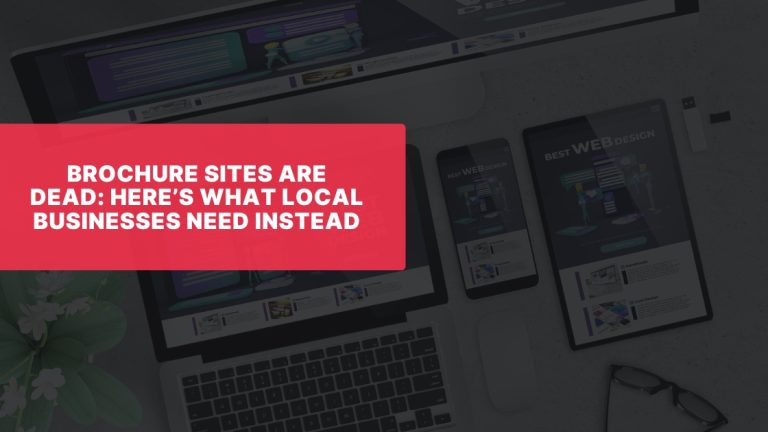You don’t need a huge website with dozens of pages and fancy features to make an impact online. In fact, some of the highest-performing websites are just a few pages long – but they’re focused, well-designed, and built to convert.
If you’re a small business with a small website (or thinking of getting one), this guide will show you how to make it feel bigger, more professional, and more trustworthy – without spending a fortune.
Why small websites work
Many small business owners think they need a massive site to look credible. The truth is, you don’t. A lean, clear, and well-structured site can do just as much (if not more) than a bulky one that’s hard to navigate.
Benefits of a small site:
- Easier to build and manage
- Faster loading and better on mobile
- Lower development costs
- Easier for visitors to find what they need
It’s not about how many pages you have – it’s about what you do with them.
1. Start with a strong homepage
Your homepage is your digital shopfront. It needs to make a strong first impression and clearly explain what you do, who it’s for, and how to take the next step.
Include:
- A bold headline that explains what you offer
- A short intro paragraph with benefits
- A clear call to action (“Get a Quote”, “Book a Call”)
- A few trust signals (testimonials, logos, reviews)
Use clear, benefit-led language that speaks directly to your ideal customer.
2. Keep navigation simple
One thing small websites often do better than big ones is navigation. Don’t overthink it – just include the essentials:
- Home
- About
- Services (or What We Do)
- Contact
Stick to 3 to 5 main pages. Use clear menu labels and make sure everything works properly on mobile.
3. Make every page count
With fewer pages, each one has to pull its weight. Every page should have a clear purpose, a strong message, and a next step.
Tips:
- Use subheadings to break up content
- Keep paragraphs short and easy to scan
- Include calls to action throughout
- Add real photos and testimonials where possible
If you don’t have many pages, make sure each one does a great job of explaining, reassuring, and encouraging action.
4. Add trust and credibility
Even if your site is small, it can still feel like a trusted brand. People want to feel confident they’re in the right place – so give them the proof.
Ways to build trust:
- Show 3 to 5 real reviews or testimonials
- Use high-quality images (preferably of your work or team)
- Add a short About section with a friendly photo
- Display certifications, associations, or awards
Trust is one of the biggest conversion drivers – and it doesn’t need to take up much space.
5. Use bold, clean design
Design doesn’t mean complicated. In fact, simple is usually better. A clean, modern layout with plenty of space makes your website feel more professional and easier to use.
Design tips for small sites:
- Stick to 1 or 2 fonts
- Use your brand colours consistently
- Avoid clutter or unnecessary effects
- Make buttons easy to see and click
Use bold section breaks, images, and icons to guide people through your site and make each section stand out.
6. Make it mobile-first
Most of your visitors are on their phones. If your small website isn’t mobile-friendly, it’ll feel even smaller – and not in a good way.
Mobile must-haves:
- Fast load time
- Easy tap targets (buttons and menus)
- Text that’s large enough to read
- Click-to-call phone numbers and contact forms that work
A small website that works beautifully on mobile can outperform larger, clunkier competitors.
7. Add personality with content
What makes a small site stand out is personality. Use your content to sound human, helpful, and real. You don’t need a huge blog – just a few useful pages or articles that show you know your stuff.
Ideas:
- A quick FAQ page
- A short “How It Works” guide
- A behind-the-scenes story or intro video
- A one-page checklist or downloadable resource
When visitors feel like they know you, they’re more likely to get in touch.
8. Focus on one goal
Every small website should have one primary goal. Whether that’s getting quote requests, booking calls, or sending enquiries – your entire site should lead people to that one action.
Make that goal obvious with:
- Clear buttons
- Consistent calls to action
- No distractions or mixed messages
If every page gently nudges people toward that goal, your site will perform better – no matter how small it is.
9. Track your performance
Even small sites should be tracked and improved over time. Use basic tools like:
- Google Analytics
- Google Search Console
- A simple contact form plugin with tracking
Keep an eye on how people are using your site and tweak things that aren’t working.
Final thoughts
You don’t need a big website to get big results. A well-structured, focused, and mobile-friendly site with clear messaging and trust signals can do more for your business than a bloated site with 20 unused pages.
Focus on clarity, quality, and usability. Make it easy for people to understand what you do, why they should choose you, and how to take the next step.
At Strategy8, we help small businesses across the UK build powerful websites that feel bigger than they are. If you’d like a free review or want to upgrade your current site without breaking the bank, get in touch.




